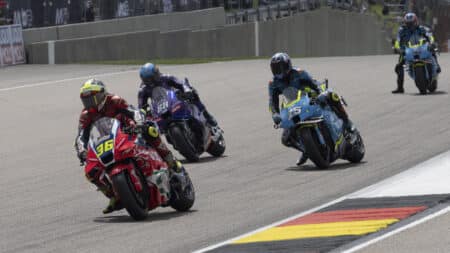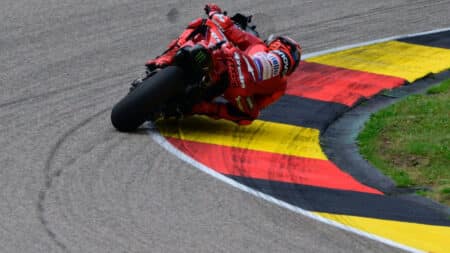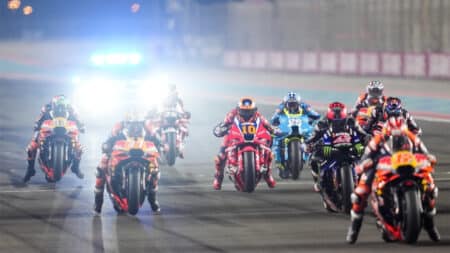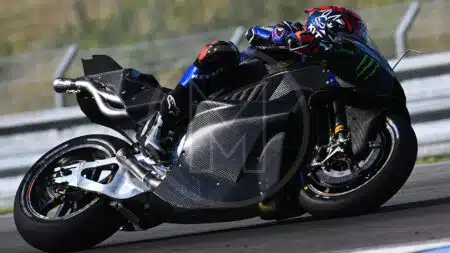Decisions, decisions, decisions… racers make tens of thousands of them every race, and each and every one of them can make the difference between victory and defeat, even between life and death.

With hindsight, there’s no doubt that Marc Márquez made the wrong decision to stay out on slicks as the rain in Spain swept across the Aragon plain on Sunday. But what if he hadn’t crashed and had crossed the line in front of his rivals equipped with rain tyres? We would be in awe of his ability to find grip where no else can. The headlines, no doubt, would’ve suggested he can walk on water.

In racing, especially when there’s only a narrowing dry line, there’s a narrow line between hero and idiot. We know this, but Ralf Waldmann reminded us of it so beautifully during the British 250 GP at Donington Park in 2000. That race started with intermittent rain falling. After much panic on the grid, wheels and spanners flying in all directions, most riders chose wet fronts and intermediate rears. Racers, like everyone, are like sheep: if a few riders go one way, most will follow.
Waldmann, however, was sat on the second row wearing wets front and rear. At this point he was the idiot. When the race started the track dried and Waldmann went backwards, until he was almost a full lap behind leader Olivier Jacque. What a fool.
Then it started raining again and pretty soon Waldmann was the fastest man on track. As he started the last lap he was still seven seconds down on the leader and as he exited the final hairpin he was still behind. But his wets gave him so much more drive that he rocketed past Jacque to win by three tenths.

Waldmann in 2002
Waldmann had already suffered the slings and arrows of Grand Prix racing for many a season, so he had seen it all before. In 1992 he led the 125 series by a mile when his season went pear-shaped, which culminated with his mechanics having a punch-up in the pitlane. At Donington in 2000 he was completely out of the title fight, so he had the luxury of rolling the dice and hoping against hope that he might win the bet.
After the race Waldmann grinned a careworn grin and laughed, “When the race started on wet tyres, I was an idiot. Then when it started raining and I could win, I was a hero. The difference between idiot and hero is very small.
Márquez only did the same thing on Sunday. As he said after the race, “I bet everything on red but black came up”. It could so easily have been the other way around.
Top racers are by nature optimists, bolstered by massive self-belief, which makes them able to attempt things most of us would never even consider. But there is a particular problem that concerns riders when they are racing around at full speed on burning hot slicks as rain starts to fall. The tyres are so hot that they continue to work in the damp, so well in fact that the rider thinks, ‘wow, I’ve still got tons of grip, I can handle this’.

Of course, he slows a little: gentler on the brakes, gentler on the throttle. At the same time the moisture cools the track surface. Both these factors reduce the temperature of the tyres, degree by degree.
Still, the slicks continue to grip and the rain continues to fall. The rider keeps going as fast he dares, one eye on his pitboard, doing frantic mental arithmetic: if there’s five laps left and I’m losing so many seconds a lap, will I lose more by staying out on slicks or by entering the pits and changing to my spare bike with wets? It costs around 25 seconds to enter the pits, swap bikes and rejoin the track. So Márquez is riding around, on a 220mph motorcycle, teetering on the brink of disaster, chased by team-mate Dani Pedrosa while adding and subtracting, multiplying and dividing.
And while he’s doing all this the rain intensifies and he slows some more, so his slicks cool some more and finally they reach that critical temperature where they no longer grip, at all. And not only that, when slick tyres get too cold they give no warning of impending disaster, so not even the man with the fastest reactions in racing can do anything about it when they let go.

On lap 15 of 23 Márquez was still riding at full speed, with a 1min 49sec lap, despite seeing drops of rain on his visor. Next time around he had slowed to 1mim 54sec, then to 1min 57sec, which is when Aleix Espagaró started the pitlane rush. Márquez calculated that he was losing between five and eight seconds per lap compared to a normal lap on rain tyres. His arithmetic seemed to add up.
On lap 18, just five to go, Márquez had dropped his pace to 2min 3sec, but he was still the fastest man on track. On lap 19 he took the lead from Pedrosa, even though he was down to a 2min 8sec. The following lap the rain started hammering down and Pedrosa went flying when he touched the brakes for Turn One, just a few yards behind the leader.
Taking the lead was perhaps Márquez’s first mistake. If he had stayed behind his team-mate, perhaps Pedrosa’s crash would’ve convinced him to come into the pits, as it did Lorenzo, who had seen Pedrosa skating along on his backside. That’s an ancient racing pearl of wisdom: you don’t want to lead in changing conditions because the leader always hits the wet patch first.
With grip fast disappearing, Márquez tiptoed his way through lap 20 at 2min 15sec, but he had increased his lead because Lorenzo had been into the pits. With three laps to go he still had a 24 second advantage.

And that’s about as far as he got. As he peeled into Turn Two for the 21st turn the front let go, Márquez grimly holding the handlebars until he cart-wheeled through the gravel.
Until that moment, he had made the right decision. With the luxury of hindsight we can say his biggest mistake was calculating lap times rather than considering the inevitably of a crash. Márquez may have supernatural feel for the tyres, but no feel equals no control, even for him.
In that split second, the right decision became the wrong decision; he had crossed the line from hero to zero. Should someone at Repsol Honda have told him to change tyres? We saw mentor Emilio Alzamora and crew chief Santi Hernández exchanging sharp words in the pit at this moment, but who was arguing for what? After the race Alzamora said they’d been talking “about nothing”. Like any good team, Márquez’s crew closes ranks in times of difficulty.
Anyway, only the rider knows how much grip he’s got. It has to be his decision because it’s his life and limbs at stake. This isn’t Formula 1, with the luxury of ship-to-shore radios and carbon-fibre safety cells.

I suspect that Márquez’s Misano and Aragon errors were a consequence of his gargantuan points lead. At Misano he risked everything to win because he wanted to celebrate securing the title with his home crowd at Aragon, where he announced that he would still risk everything because he wanted to win the race in front of his fans. In other words, his huge points advantage had him thinking about things he shouldn’t be thinking about. But huge respect to him for that: Márquez is a real racer who wants to win, almost whatever the cost.
So far he has had the luxury of messing up with impunity and he goes into the final four races enjoying a 75-point lead, so he only needs 25 points from those races to retain his title. Expect a more reticent approach from the kid genius at the next race or two, until the title is his once again.












